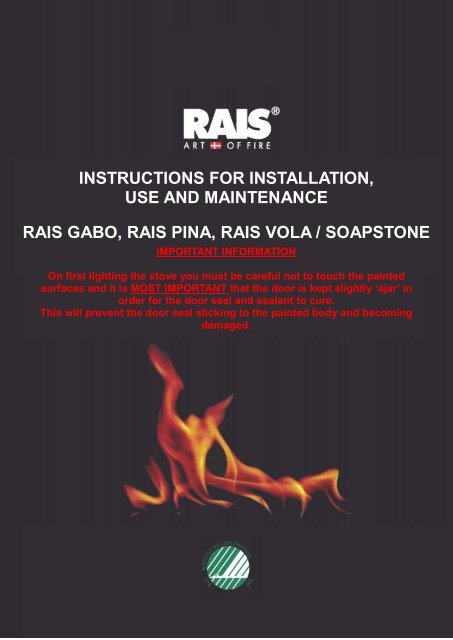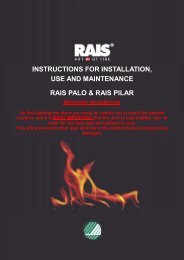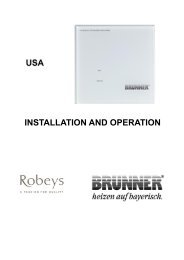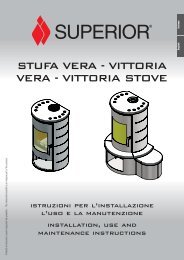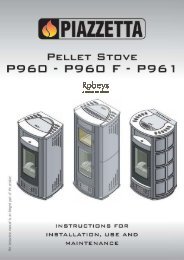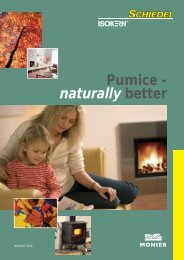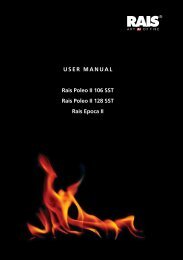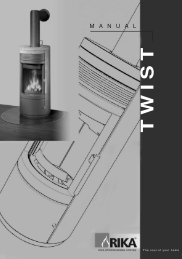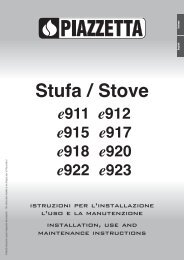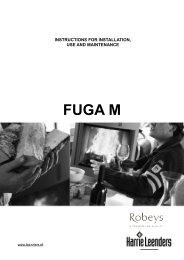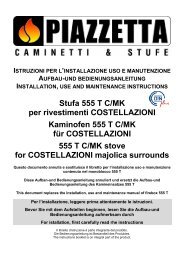instructions for installation, use and maintenance rais ... - Robeys Ltd
instructions for installation, use and maintenance rais ... - Robeys Ltd
instructions for installation, use and maintenance rais ... - Robeys Ltd
You also want an ePaper? Increase the reach of your titles
YUMPU automatically turns print PDFs into web optimized ePapers that Google loves.
ENGLISHRAIS manual <strong>for</strong> Rais Gabo, Pina, Vola & Vola SoapstoneINSTRUCTIONS FOR INSTALLATION,USE AND MAINTENANCERAIS GABO, RAIS PINA, RAIS VOLA / SOAPSTONEIMPORTANT INFORMATIONOn first lighting the stove you must be careful not to touch the paintedsurfaces <strong>and</strong> it is MOST IMPORTANT that the door is kept slightly ‘ajar’ inorder <strong>for</strong> the door seal <strong>and</strong> sealant to cure.This will prevent the door seal sticking to the painted body <strong>and</strong> becomingdamaged.1
ENGLISHRAIS manual <strong>for</strong> Rais Gabo, Pina, Vola & Vola Soapstone2
ENGLISHRAIS manual <strong>for</strong> Rais Gabo, Pina, Vola & Vola SoapstoneRais Gabo, Rais Pina, Rais Vola <strong>and</strong> Rais Vola SoapstoneRevision :Date : 2011INTRODUCTION ...………………………………………………………….. 4WARRANTY ..…………………………………………………….………….. 4SPECIFICATIONS ………………………………………………………….. 5CONVECTION ………………………………………………………………. 6INSTALLATION INSTRUCTIONS ………………………………….……… 7CHIMNEY ………………………………………………………….…………. 89INSTALLATION ……………………………………………………………... 10OPERATION OF SWIVEL BASE ….………………………………………. 11INSTALLATION OF SOAPSTONE ( VOLA SOAPSTONE ) ….……….. 1213INSTALLATION DISTANCE TO COMBUSTIBLE WALL ……………… 16GENERAL INSTALLATION ( RIGHT ANGLE ) SECURE BASE ….….. 16CORNER INSTALLATION 45° …………………………………. 16360° SWIVEL BASE …………………………………………….. 1790° SWIVEL BASE ………………………………………………. 17INSTALLATION DISTANCE TO NONCOMBUSTIBLE WALL ………. 17FOR THE INSTALLER ……………………………………………………… 18OPERATING INSTRUCTIONS …………………………………………….. 19FUEL …………………………………………………………………………... 19DRYING AND STORAGE …………………………………………………… 20REGULATION OF COMBUSTION AIR …………………………………… 21USING THE WOOD BURNING STOVE …………………………………… 22FIRST USAGE ………………………………………………………………… 23LIGHTING AND FUELLING ………………………………………………… 2425CLEANING AND CARE …………………………………………………….. 26CLEANING OF THE FLUE WAYS ………………………………………… 27PROBLEM SOLVING ……………………………………………………….. 28ACCESSORIES AND SPARE PARTS ……………………………………. 29SPARE PART DIAGRAM …….………..……………………………………. 29343
ENGLISHRAIS manual <strong>for</strong> Rais Gabo, Pina, Vola & Vola SoapstoneIntroductionThank you <strong>for</strong> purchasing a Rais wood burning stove.These appliances have been approved by HETAS asintermittent operating appliances <strong>for</strong> burning wood logs only.A Rais wood burning stove is more than just a heat source: it also shows that you careabout design <strong>and</strong> quality in your home.To make the most of your wood burning stove it is important that you read the manualthoroughly be<strong>for</strong>e installing <strong>and</strong> using it.In the case of warranty coverage, <strong>and</strong> <strong>for</strong> general queries regarding your wooding stove, it is important that you know the stove’s production number.We there<strong>for</strong>e recommend that you note down the number in the table below.The production number is located in the top of the convection box.burnWarrantyYour Rais wood burning stove comes with a 5 year warranty.The warranty, however, does not cover heatinsulating materials, glass <strong>and</strong> seals.These are available to order from your local Rais dealer / stockist.Any alterations made to the stove will void the warranty.4
ENGLISHRAIS manual <strong>for</strong> Rais Gabo, Pina, Vola & Vola SoapstoneRais Gabo Rais Pina Rais Vola Rais VolaSoapstoneNominal output (kW): 5 5 5 5Min. / Max. output (kW): 2 6 2 6 2 6 2 6Heating area (m 2 ): Ca. 80 Ca. 80 Ca. 80 Ca. 80Size, width/depth/height (mm): 510 / 460 / 1005 552 / 455 / 1120 530 / 421 /1190540 / 430 /1230Combustion chamber width/depth/height (mm). 376 / 245 / 367 376 / 245 / 367 376 / 245 / 367 376 / 245 / 367Recommended amount of wood when fuelling (kg)(Based on 2 3 logs of wood approx. 25cm)1.5 1.5 1.5 1.5Min. uptake / Min. draught (Pascal): 12 12 12 12Weight (kg): 140 140 150 203Efficiency (%):Particles after NS3058/3059 (g/kg):Dust measured according to Din+ (mg/Nm 3 ):Smoke gas mass flow (g/s): 5.4 5.4 5.4 5.4Smoke gas temperature (°C): 260 260 260 260Intermittent operation: Fuelling should be undertaken within 3 hours5
ENGLISHRAIS manual <strong>for</strong> Rais Gabo, Pina, Vola & Vola SoapstoneConvectionRais stoves are convection stoves. This means that the stove’s back <strong>and</strong> side panels arenot overheated. Convection means that there is a circulation of air, which ensures thatthe heat is distributed more evenly throughout the entire room. The cold air is sucked in atthe base of the stove <strong>and</strong> up through the convection channel, which runs along thestove’s combustion chamber. The heated air comes out at the top of the stove, whichensures a circulation of warm air throughout the room.The stoves are equipped with cool door h<strong>and</strong>les a Rais special feature which meansyou could almost do away with gloves. Be aware, however, that all exterior surfacesbecome hot during <strong>use</strong> so take extreme care.6
ENGLISHRAIS manual <strong>for</strong> Rais Gabo, Pina, Vola & Vola SoapstoneInstallation InstructionsThe following pages give <strong>instructions</strong> <strong>for</strong> the safe <strong>and</strong> proper <strong>installation</strong> of this heatingappliance in the UK. These <strong>instructions</strong> cover the basic principles of <strong>installation</strong>,although some details may need slight modification to suit particular local site conditions.In all cases the <strong>installation</strong> must comply with current UK Building Regulations, LocalAuthority Byelaws <strong>and</strong> other specifications or regulations as they affect the <strong>installation</strong> ofthe stove.Please note that it is a legal requirement under Engl<strong>and</strong> <strong>and</strong> Wales Building Regulationsthat the <strong>installation</strong> of the stove is either carried out under local Authority BuildingControl approval or is installed by a Competent Person registered with a Governmentapproved Competent Persons Scheme. HETAS operate such a scheme <strong>and</strong> a listing oftheir registered Competent Persons can be found on their website at www.hetas.co.uk.It should be noted that the current Building Regulations requirements are given inApproved Document J. These requirements may also be met by adopting the relevantrecommendations given in British St<strong>and</strong>ards BS 8303, BS 6461 <strong>and</strong> BS 7566.WARNING. Health <strong>and</strong> Safety Advice Notice.The <strong>installation</strong> of this heating appliance is governed by the Health <strong>and</strong> Safety at WorkAct 1974. it is the responsibility of the installer to ensure that all requirements of this Actare met during the <strong>installation</strong> works. Attention is drawn in particular to the following:H<strong>and</strong>ling:The appliance is a heavy item <strong>and</strong> adequate facilities must be available<strong>for</strong> loading, unloading <strong>and</strong> site h<strong>and</strong>ling.Fire Cement: Some types of fire cement are caustic <strong>and</strong> should not be allowed to comeinto contact with the skin. Protective gloves should be worn whenh<strong>and</strong>ling fire cement. In case of contact with the skin, wash immediatelywith plenty of water.Asbestos:Metal Parts:This stove contains no asbestos. If there is a possibility of disturbing anyasbestos in the course of the <strong>installation</strong>, then please seek specialistguidance <strong>and</strong> <strong>use</strong> appropriate protective equipment.When installing or servicing this stove care should be taken to avoid thepossibility of personal injury.Important Warning Preparatory Work <strong>and</strong> safety Checks:· This stove must not be installed into a chimney which serves any other heatingappliance.· There must not be an extractor fan fitted in the same room as the stove, as this canca<strong>use</strong> the stove to emit fumes into the room.· If this appliance is installed into an existing chimney, the chimney must first beswept <strong>and</strong> examined <strong>for</strong> soundness <strong>and</strong> suitability, be<strong>for</strong>e the appliance is installed(see also section headed ‘Chimney’).7
ENGLISHRAIS manual <strong>for</strong> Rais Gabo, Pina, Vola & Vola SoapstoneChimneyThe chimney is the driving <strong>for</strong>ce which makes the stove function. In order <strong>for</strong> the stove toper<strong>for</strong>m satisfactorily the chimney height must be sufficient to ensure the correct draughtof 14 to 18 Pa, so as to clear the products of combustion <strong>and</strong> prevent problems of smokeleaking into the room when the stove is lit.Note: A chimney height of not less than 4.5 metres, measured vertically from the outlet ofthe stove to the top of the chimney, should be satisfactory.Alternatively the calculation procedure given in BS 5854:1980 may be <strong>use</strong>d as the basis<strong>for</strong> deciding whether a particular chimney design will provide sufficient draught.The outlet from the chimney should be above the roof of the building in accordance withthe provisions of the Building Regulations Approved Document J.If the <strong>installation</strong> is into an existing chimney, then it must be sound <strong>and</strong> have no cracks orother faults which may allow fumes into the ho<strong>use</strong>. Older properties, especially, may havechimney faults or the cross section may be too large i.e. more than 230 x 230mm.Remedial action should be taken if required, expert advice should be sought whererequired.If the chimney requires lining, then a suitable solid fuel flue liner must be <strong>use</strong>d, inaccordance with Building Regulations Approved Document J.Any existing chimney must be clear of obstruction <strong>and</strong> should have been swept cleanimmediately be<strong>for</strong>e the <strong>installation</strong> of the stove. If the stove is fitted in place of an openfire, then the chimney should be swept one month after <strong>installation</strong> to clear any soot fallswhich may have occurred due to the difference in combustion between the stove <strong>and</strong> theopen fire.If there is no existing chimney then either a prefabricated block chimney, in accordancewith Building Regulations Approved Document J or a twin wall insulated stainless steelflue to BS 4543 can be <strong>use</strong>d. These chimneys must be fitted in accordance with themanufacturer’s <strong>instructions</strong> <strong>and</strong> the Building Regulations.A single wall metal fluepipe is suitable <strong>for</strong> connecting the stove to the chimney but isnot suitable <strong>for</strong> using <strong>for</strong> the complete chimney. The chimney <strong>and</strong>connecting fluepipe must have a minimum diameter of 150mm <strong>and</strong> it’sdimension should be not less than the size of the outlet socket of the stove which is150mm. Any bend in the chimney or connecting fluepipe should not exceed 45°. 90°bends should not be <strong>use</strong>d.Combustible material should not be located where the heat dissipating through thewalls of fireplaces or flues could ignite it. There<strong>for</strong>e when installing the stove in thepresence of combustible materials due account must be taken of theguidance on the separation of combustible material given in Building Regulations ApprovedDocument J <strong>and</strong> also in these stove <strong>instructions</strong>.8
ENGLISHRAIS manual <strong>for</strong> Rais Gabo, Pina, Vola & Vola SoapstoneIf it is found that there is excessive draught in the chimney then either anadjustable flue damper or alternatively a draught stabiliser should be fitted. Theadjustable flue damper should not close off the flue entirely, but should in itsclosed position leave a minimum continuous opening free area of at least 20 %of the total cross sectional area of the flue or fluepipe.Adequate provision e.g. easily accessible soot door or doors must be provided<strong>for</strong> sweeping the chimney <strong>and</strong> connecting fluepipe.You should also familiarise yourself with the draught conditions <strong>for</strong> chimneyswith 2 flues.For strong draughts, the chimney or flue should be fitted with a draughtstabiliser. In which case, it is important to ensure that there is a free flowthrougharea of minimum 20 cm 2 when the regulating gate is shut. Otherwise, the fuelenergy may not be <strong>use</strong>d optimally.If, at any time, you are unsure about the condition of the chimney, you shouldcontact a chimney sweep.Remember that access to the soot door should be kept clear.9
ENGLISHRAIS manual <strong>for</strong> Rais Gabo, Pina, Vola & Vola SoapstoneInstallationIt is prohibited to carry out unauthorised alterations to the stove.There must be plenty of fresh air in the room where the stove is being installed, in order toensure proper combustion. Note that any mechanical exhaust ventilation e.g. anextraction hood may reduce the air supply. Any air grilles must be placed in such amanner, that the air supply is not blocked.The stove is equipped with four convection air outlets, which may be connected withsuitable air ducts to other rooms.Building Regulations Approved Document J gives specific guidance on the requiredpermanent ventilation into the room <strong>for</strong> combustion air of solid fuel appliances.The floor structure must be able to carry the weight of the wood burning stove, as well asthe weight of a chimney, if necessary.When you choose where to set up your RAIS wood burning stove, you should consider theheat distribution to the other rooms. This will enable you to get the best <strong>use</strong> out of yourstove.The stove should be set up at a safe distance from inflammable materials.See the manufacturer's plate on the wood burning stove.10
ENGLISHRAIS manual <strong>for</strong> Rais Gabo, Pina, Vola & Vola Soapstone11
ENGLISHRAIS manual <strong>for</strong> Rais Gabo, Pina, Vola & Vola SoapstoneIf the stove has a turntable then pleasedo the following:Lift up the positioning bolt <strong>and</strong> rotate thestove at 30° intervals.When you have reached the desiredposition, release the positioning bolt, <strong>and</strong>turn the stove slightly until the bolt clicksinto place.12
ENGLISHRAIS manual <strong>for</strong> Rais Gabo, Pina, Vola & Vola SoapstoneMount the Soapstones as illustrated:1. Remove the screw ( 1 )2. Remove the back panel ( 2 )3. Loosen the nut ( 3 ) under the top plate.4. Remove the top plate ( 4 ) push the topplate backwards <strong>and</strong> lift up.13
ENGLISHRAIS manual <strong>for</strong> Rais Gabo, Pina, Vola & Vola Soapstone5. Carefully place the Soapstone on thesocket ( 6 )6. Push the two flat head screws ( 7 )through the plate ( 8 )7. Put the brass bushes ( 9 ) onto thescrews between the plate <strong>and</strong> theSoapstone ( 5 )8. Tighten the flat head screw into theSoapstone bush ( 10 )8. Mount the top plate ( 4 ) lower the topplate into the slot <strong>and</strong> push it carefullytoward the front of the stove14
ENGLISHRAIS manual <strong>for</strong> Rais Gabo, Pina, Vola & Vola Soapstone10. Refasten the nut under the top plate ( 3 )11. Replace the back panel ( 2 )12. Replace the screw ( 1 ) <strong>and</strong> fasten theback panel ( 2 )13. Carefully place the Soapstone top plate( 11 ) onto the steel top plate15
ENGLISHRAIS manual <strong>for</strong> Rais Gabo, Pina, Vola & Vola SoapstoneInstallation distance in case of combustible wallTo find out whether the wall next to where the stove is going to be installed is flammable,you should contact your building contractor or the local building authorities.The hearth should be able to accommodate the weight of the stove. The chimney must beindependently supported by wall brackets or a ceiling support plate. The weight of the stoveis indicated in the brochure.The stove should always be installed on a noncombustible hearth of a size <strong>and</strong> constructionthat is in accordance with the provisions of the current UK Building Regulations ApprovedDocument J.If the stove is to be installed on a wooden floor, it must be covered with a noncombustiblematerial at least 12mm thick, in accordance with UK Building Regulations ApprovedDocument J, to a distance of 300 mm in front of the stove <strong>and</strong> 150 mm to each sidemeasuring from the door of the combustion chamber.The clearance distances to combustible material beneath, surrounding or upon the hearth<strong>and</strong> walls adjacent to the hearth should comply with the guidance on the separation ofcombustible material given in UK Building Regulations Approved Document J <strong>and</strong> also inthese stove <strong>instructions</strong>.16
ENGLISHRAIS manual <strong>for</strong> Rais Gabo, Pina, Vola & Vola SoapstoneInstallation distance <strong>for</strong> noncombustiblewalls.We recommend a minimum distance tononcombustible material of 50mm (F) <strong>for</strong>cleaning considerations.17
ENGLISHRAIS manual <strong>for</strong> Rais Gabo, Pina, Vola & Vola SoapstoneFor the InstallerFinally be<strong>for</strong>e firing the stove <strong>for</strong> the first time a check should be made to ensure that theassembly <strong>and</strong> stove <strong>installation</strong> has been satisfactory <strong>and</strong> that there are no leaks in anyseals in the appliance <strong>and</strong> appliance connections to the chimney.Ensure that the appliance <strong>and</strong> chimney flue are functioning correctly be<strong>for</strong>e finallyh<strong>and</strong>ing over to the <strong>use</strong>r. Read the later parts of this manual <strong>for</strong> guidance on carerequired when first lighting.In<strong>for</strong>m the <strong>use</strong>r that the appliance has been commissioned <strong>and</strong> ready to <strong>use</strong> <strong>and</strong> giveinstruction on the safe operation of the stove.These Instructions must be left with the <strong>use</strong>r <strong>and</strong> the <strong>use</strong>r should be instructed to keepthem in a safe place.18
ENGLISHRAIS manual <strong>for</strong> Rais Gabo, Pina, Vola & Vola SoapstoneOperating <strong>instructions</strong>Please note that HETAS Appliance Approval only covers the <strong>use</strong> of dry seasoned woodlogs on this appliance. HETAS Approval does not cover the <strong>use</strong> of other fuels eitheralone or mixed with the wood logs, nor does it cover <strong>instructions</strong> <strong>for</strong> the <strong>use</strong> of otherfuels.FuelThe stove is designed <strong>and</strong> approved in accordance with EN 13240 <strong>and</strong> NS 3058 <strong>for</strong>stoking split, dried firewood. The firewood must have a water content of 1522% <strong>and</strong> itsmax. length should be the length of the combustion chamber minus 5060 mm.Stoking with wet firewood ca<strong>use</strong>s both soot, environmental pollution <strong>and</strong> bad fueleconomy. Freshly cut wood contains approx. 5070% water <strong>and</strong> is thoroughly unsuitable<strong>for</strong> stoking. Allow at least 1 year of storage time <strong>for</strong> newly cut wood be<strong>for</strong>e using. Woodwith a diameter of more than 100 mm should be split. Regardless of wood size, it shouldalways have at least one surface area free of bark.We do not recommend stoking with painted, laminated or impregnated wood, wood witha synthetic surface, painted ref<strong>use</strong> wood, chipboard, plywood, domestic waste, paperbriquettes <strong>and</strong> pit coal, as this will produce malodorous smoke, which could bepoisonous.When firing with the abovementioned items <strong>and</strong> amounts larger than thoserecommended, the stove is subjected to a larger amount of heat, which results in ahigher chimney temperature <strong>and</strong> lower efficiency. This can result in the stove <strong>and</strong>chimney becoming damaged <strong>and</strong> would void the warranty.The calorific value of the firewood is closely connected to the moisture level.Moist firewood has a low heat value. The more water the wood contains, the moreenergy it takes <strong>for</strong> this water to vaporise, resulting in this energy being lost.ONLY USE RECOMMENDED FUELSThe following table shows the calorific value of different types of wood, which have beenstored <strong>for</strong> 2 years <strong>and</strong> which have a residual moisture of 15 17%.Wood Kg dry wood pr m 3 compared to beech/oakHornbeam 640 110%Beech <strong>and</strong> oak 580 100%Ash 570 98%Maple 540 93%Birch 510 88%Mountain pine 480 83%Fir 390 67%Poplar 380 65%1kg of wood yields the same heat energy irrespective of wood type.1kg of beech merely takes up less space than 1kg of fir.19
ENGLISHRAIS manual <strong>for</strong> Rais Gabo, Pina, Vola & Vola SoapstoneDrying <strong>and</strong> storageDrying wood takes time: proper air drying takes approximately 2 years.Here are some tips:Store the wood sawn, split <strong>and</strong> stacked in an airy, sunny place, which is protected againstrain (the south side of the ho<strong>use</strong> is particularly suitable).Store the firewood stacks at a h<strong>and</strong>'s breadth apart, as this ensures that the air flowingthrough takes the moisture with it. Avoid covering the firewood stacks with plastic, as thisprevents the moisture from escaping. It is a good idea to bring the firewood into the ho<strong>use</strong>23 days be<strong>for</strong>e you need it.20
ENGLISHRAIS manual <strong>for</strong> Rais Gabo, Pina, Vola & Vola SoapstoneRegulating the combustion airAll RAIS stoves are equipped with a oneh<strong>and</strong>ed operating lever <strong>for</strong> regulating the damper.The stovespecific regulating mechanisms can be seen on the diagrams.Primary air is the combustion air added to the primary combustion zone, i.e. the bed ofglowing embers. This air, which is cold, is only <strong>use</strong>d in the lighting stage. Secondary air isthe air which is added in the gas combustion zone, i.e. air which contributes to thecombustion of the pyrolysis gasses (preheated air, which is <strong>use</strong>d <strong>for</strong> the cleaner glasssystem <strong>and</strong> combustion). This air is sucked through the damper under the combustionchamber <strong>and</strong> is preheated through the side channels <strong>and</strong> then emitted as hot scavengingair onto the glass. The hot air rinses the glass <strong>and</strong> keeps it sootfree.The tertiary channel, which can be seen at the top of the combustion chamber towards theback, serves to combust the final gas residues.By setting the interval between position 1 <strong>and</strong> 2, the energy content in the firewood is <strong>use</strong>doptimally, as there is oxygen <strong>for</strong> combustion <strong>and</strong> <strong>for</strong> the burning of the pyrolysis gasses.When the flames are a clear yellow the damper has been set correctly. Finding the correctposition comes with time after you have <strong>use</strong>d <strong>for</strong> stove <strong>for</strong> a while.It is not recommended that you turn it down completely. A mistake commonly made isshutting the damper too early beca<strong>use</strong> it feels too hot. This results in dark smoke emanatingfrom the chimney <strong>and</strong> in the calorific value of the firewood not being <strong>use</strong>d to its fullest.Room ventilation <strong>and</strong> stovesThere must not be an extractor fan fitted in the same room as the stove as this can ca<strong>use</strong>the stove to emit smoke <strong>and</strong> fumes into the room.The stove requires a permanent <strong>and</strong> adequate air supply in order <strong>for</strong> it to operate safely <strong>and</strong>efficiently.In accordance with current Building Regulations the installer may have fitted a permanent airsupply vent into the room in which the stove is installed to provide combustion air. This airvent should not under any circumstances be shut off or sealed.21
ENGLISHRAIS manual <strong>for</strong> Rais Gabo, Pina, Vola & Vola SoapstoneUsing the wood burning stoveAdjusting the air damper.The damper has 3 settings.Position 1The damper is closed meaning that there is no airintake.Position 2Push the lever until the first click. This positiongives full secondary air.During normal <strong>use</strong> the lever is set between position1 <strong>and</strong> 2.When the flames are clear <strong>and</strong> yellow, the damperis set correctly, i.e. resulting in a slow/optimalburning.Position 3Pull the h<strong>and</strong>le out, <strong>and</strong> push it to the right.The air damper is completely open <strong>and</strong> gives fullprimary <strong>and</strong> secondary air. This position is <strong>for</strong> thelighting stage <strong>and</strong> is not <strong>use</strong>d under normaloperation.ControlIf the ash is white <strong>and</strong> the walls in the combustion chamber are soot free after the stovehas been <strong>use</strong>d, the air regulation was set correctly <strong>and</strong> the wood was sufficiently dry.22
ENGLISHRAIS manual <strong>for</strong> Rais Gabo, Pina, Vola & Vola SoapstoneTo light the stove, <strong>use</strong> alcohol briquettes orsimilar, as well as approximately 2kg offirewood, split into kindling sticks. Set the airdamper to the fully open position.Tips be<strong>for</strong>e firing up:Open a door or window close to the woodburning stove.If there is ‘storm’ in the stove coming fromthe chimney it is advisable to place ascrewed up piece of newspaper betweenthe upper baffle plate <strong>and</strong> the chimney.Light the paper <strong>and</strong> wait until you hear a‘rumbling’ noise in the chimney. This meansthat there is definitely a draught in thechimney <strong>and</strong> you should avoid smokecoming back into the room.Light the fire <strong>and</strong> shut thedoor, leave the door ajarapproximately 1015mm.24
ENGLISHRAIS manual <strong>for</strong> Rais Gabo, Pina, Vola & Vola SoapstoneWhen the flames are clear, after approximately 510minutes, close the door.Damper see adjustment of the damper.After approximately 1020 minutes, when you have agood bed of glowing embers, add 23 pieces of wood.Leave the door ajar until the fire has caught properly,then close the door.Damper see adjustment of the damper.After approximately 5 minutes, or when the flames areclear <strong>and</strong> stable, close the damper gradually.It is recommended to have a layer of approximately20mm, as it has an insulating effect.NOTE!During operation thedoor should alwaysremain closed.25
ENGLISHRAIS manual <strong>for</strong> Rais Gabo, Pina, Vola & Vola SoapstoneCleaning <strong>and</strong> careThe wood burning stove <strong>and</strong> the chimney must be serviced by a chimney sweep twice ayear.During cleaning <strong>and</strong> care, the stove must be cold.If the glass is sooty: Moisten a piece of paper or newspaper, dip it in the ash, <strong>and</strong> rub the sooty glass with it. Now rub with a dry piece of paper <strong>and</strong> the glass will become clean. As an alternative you can <strong>use</strong> glass cleaner, which you can buy from you RAISdistributor.Clean the exterior with a dry sponge or a soft brush.Cleaning the combustion chamber:Scrape/shovel the ash out <strong>and</strong> store it in a nonflammable container until it has cooleddown. You can dispose of ash with your normal ho<strong>use</strong>hold waste or recycle on thegarden.REMEMBER!!Never remove all the ashes from the combustion chamber the wood will burn at its bestwith a layer of ashes of approx. 20 mm.Prolonged periods of non<strong>use</strong>:If the stove is to be left un<strong>use</strong>d <strong>for</strong> a prolonged period of time then it should be given athorough clean to remove ash <strong>and</strong> unburned fuel residues. To enable a good flow of airthrough the appliance to reduce condensation <strong>and</strong> subsequent damage, leave the aircontrols fully open.Prior to a new heating season, it should be checked that the chimney <strong>and</strong> flue pipeconnector are not blocked.26
ENGLISHRAIS manual <strong>for</strong> Rais Gabo, Pina, Vola & Vola SoapstoneCleaning of the flue waysRemove the baffle plate by lifting itupwards <strong>and</strong> tilting on it’s end.The other end is lowered <strong>and</strong> thebaffle plate turned a little.Gently take out the baffle plate.Remove the upper baffle plate by pushing it towards thesmoke leader, tilting it slightly <strong>and</strong> then carefully pulling itout.Push up the smoke leader, lift itfrom the pins <strong>and</strong> then pull it outdownwards.Sweep the smoke box using ah<strong>and</strong> sweeping brush.Replace everything in reverseorder.NOTE.Make sure that the smoke leaderis placed correctly on the pins.27
ENGLISHRAIS manual <strong>for</strong> Rais Gabo, Pina, Vola & Vola SoapstoneProblem solvingSmoke spillage around door: could be due to too low draught in the chimney 22 Pa, draught control regulator should be installed.A stove burning too weakly could be ca<strong>use</strong>d by: too little firewood too little air supply <strong>for</strong> the room ventilation dirty smoke channels leaking chimney leakage between chimney <strong>and</strong> flueIf your stove continues to malfunction, we recommend that you contact your RAISdistributor or chimney sweep.IMPORTANT!!To ensure safe burning there must be clear yellow flames or clear embers at all times. Thefirewood should not be smouldering. There<strong>for</strong>e you should never completely cut off the airsupply.WARNING!!In case of chimney fire: shut off all air supply on the wood burning stove contact the fire services never attempt to put out fire with water! afterwards, you should ask your chimney sweep to check the stove <strong>and</strong> chimney28
ENGLISHRAIS manual <strong>for</strong> Rais Gabo, Pina, Vola & Vola SoapstoneAccessories <strong>and</strong> spare partsIf spare parts other than those recommended by RAIS are <strong>use</strong>d, the warranty is voided.All replacement spare parts can be purchased from your RAIS distributor / stockist.See the following spare parts diagrams <strong>for</strong> the individual products.29
ENGLISHRAIS manual <strong>for</strong> Rais Gabo, Pina, Vola & Vola Soapstone30
ENGLISHRAIS manual <strong>for</strong> Rais Gabo, Pina, Vola & Vola Soapstone31
ENGLISHRAIS manual <strong>for</strong> Rais Gabo, Pina, Vola & Vola Soapstone32
ENGLISHRAIS manual <strong>for</strong> Rais Gabo, Pina, Vola & Vola Soapstone33
ENGLISHRAIS manual <strong>for</strong> Rais Gabo, Pina, Vola & Vola Soapstone34
ENGLISHRAIS manual <strong>for</strong> Rais Gabo, Pina, Vola & Vola Soapstone35
ENGLISHRAIS manual <strong>for</strong> Rais Gabo, Pina, Vola & Vola SoapstoneU K Distributor.<strong>Robeys</strong> <strong>Ltd</strong>.Riverside, Goods Road, Belper,Derbyshire, Engl<strong>and</strong>. DE56 1UUTel: 01773 820940 Fax: 01773 820477E Mail: info@robeys.co.ukwww.robeys.co.ukJune 201136


